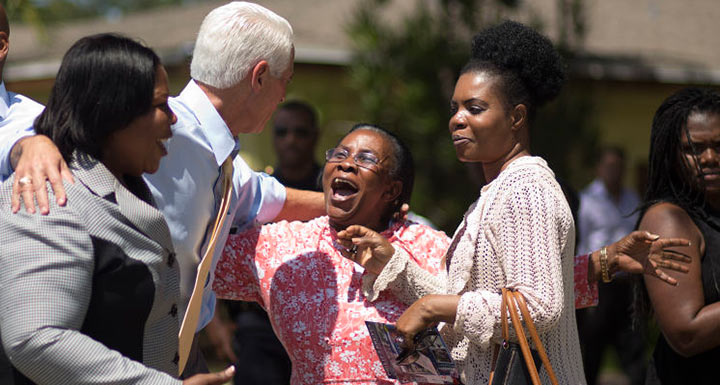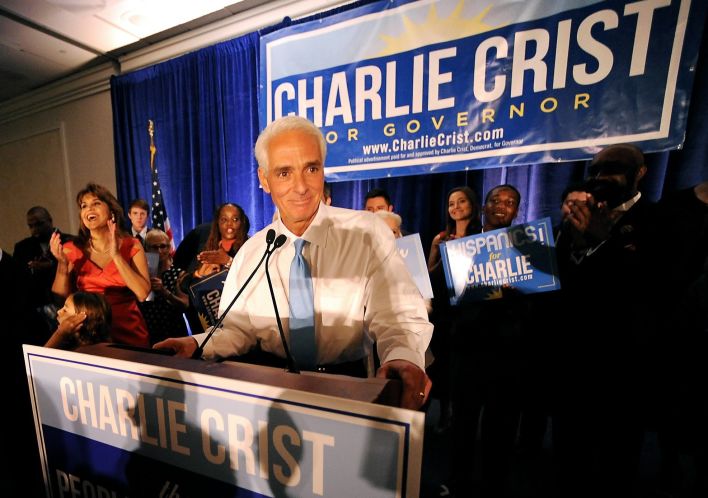
Mapping the path for Charlie Crist to be elected Florida governor again
Charlie Crist’s political fortunes have been hitched to President Barack Obama, for better or worse, since their man hug five years ago helped sink him in the Republican Party.
So it may seem counterintuitive that as the Crist campaign plots its path to victory over Gov. Rick Scott, the benchmark is not Obama winning Florida in 2008 or 2012. Rather, it’s Alex Sink’s narrow loss to Scott in 2010.
How does the former Republican governor make history by getting elected governor again as a Democrat?
The plan essentially boils down to matching Sink’s performance — the former chief financial officer lost to Scott by 1.2 percentage points, less than 62,000 votes — and then, through sophisticated computer modeling, analytics and voter targeting, to modestly improve on her showing among various voter groups that make up Florida’s complicated electoral mosaic.
“We know the universe we have to turn out,” said Omar Khan, Crist’s campaign manager and one of many Obama campaign veterans helping Crist. “Every decision we make and everything we’ve done is to get to 50 percent plus one. We know where our voters are, and we feel very comfortable.”
The Crist victory map, on the surface, seems simple enough to achieve. Crist need not do dramatically better than Sink, just improve on the margins here and there.
Based on interviews with senior members of the Crist campaign team, here are some opportunities and goals the team is focused on:
• Win 42 percent or more of the white vote, compared to the 41 percent Sink won, according to exit polls. That includes matching or exceeding the 44 percent of white women Sink won in 2010.
• Win 49 percent of the Tampa Bay region, compared to the 46 percent Sink won.
• Win at least 52 percent of the Hispanic vote, compared to the 48 percent Sink won.
• Win more Republican voters than Scott wins Democratic voters.
• Win at least 93 percent of the African-American vote and strive to increase black turnout from the 11 percent of the electorate it represented in 2010 toward the 14 percent it represented in 2012.
Some of the advantages for Crist are organic as Florida’s population and electorate steadily grow less white and thereby less Republican. That’s particularly true in the increasingly Democratic stronghold of Miami-Dade.
If Crist merely gets the same share of the vote as Sink did in Miami-Dade (56 percent), he would pick up 29,000 more votes than she did — almost half the margin of Scott’s victory in 2010. And if Democrats can ramp up turnout in Miami-Dade from the anemic 42 percent that voted in 2010 toward the 67 percent who voted in the 2012 presidential election, Crist could pick up tens of thousands of more votes.
Crist has never run for office as a Democrat, of course. Nor has he ever put much emphasis on get-out-the-vote efforts, instead relying mainly on expensive TV ad campaigns. But leaders of the Crist campaign say their field operations, especially in South Florida, are a huge reason to believe they can outperform Sink.
Although he can’t afford anything remotely as ambitious as Obama put together, Crist already has 100 paid staffers, which is unheard of for a Democratic gubernatorial campaign in Florida. Crist spent nearly $3 million building his campaign infrastructure before he aired his first TV ad in July.
Working on the campaign are a number of senior data crunchers who helped Obama for America implement the most sophisticated and successful voter targeting operation. In 2013, they started Bluelabs, a firm that helped Terry McAuliffe win Virginia’s gubernatorial race last year.
The firm, which has earned more than $200,000 from the Crist campaign since June, merges polling, demographic and consumer data to develop models that predict voter behavior and to identify people to target and messages likely to be most effective.
The electorate in an off-year-election is sure to be older, whiter and more Republican than in a high turnout presidential year. Four years ago, amid a big wave election for the GOP, Republican turnout was 8 points higher than Democratic turnout, 46 percent to 38 percent. This year, both sides expect the Republican turnout advantage to be more like 5 or 6 percentage points, as it was in 2002 and 2006.
“There’s an assumption I hear that there’s huge Republican enthusiasm out there that I’m not really sure is real,” said Steve Schale, a senior Crist campaign adviser who suggested Scott benefited in 2010 from strong Republican turnout produced by several tight congressional races. “And there’s far more enthusiasm on my side of the aisle this year for Charlie Crist than there was for Alex Sink.”
 Statewide elections in Florida tend to be won or lost along the I-4 corridor, a swath of swing voters stretching from St. Petersburg to Daytona Beach. The biggest chunk of TV spending is likely to be devoted again to the markets around Tampa and Orlando.
Statewide elections in Florida tend to be won or lost along the I-4 corridor, a swath of swing voters stretching from St. Petersburg to Daytona Beach. The biggest chunk of TV spending is likely to be devoted again to the markets around Tampa and Orlando.
“We have to get a point or two better among Republicans than Scott does among Democrats, and it’s places like Tampa Bay where you do that,” said Schale.
Performing a percentage point or two better in Republican-leaning Pasco or Sarasota counties could make the difference.
But the lion’s share of Crist’s get-out-the-vote efforts will be focused on the Democrat-rich counties of Palm Beach, Broward and Miami-Dade, which consistently underperform the rest of the state in voter turnout.
“We know the universe we have to turn out, and if we turn it out, we win the election,” Khan said.
The biggest fear for Team Crist — and main element outside their control — is Scott deciding to dig into his virtually bottomless pocket. Scott spent nearly $80 million of his own money to win the office, and he’s capable of spending as much to keep it.
Being outspent 1½-to-1 or 2-to-1 is one thing. Being outspent 3-to-1 or 4-to-1 could be impossible to overcome.
Millions of dollars in negative attack ads have driven Crist’s unfavorable ratings higher than his favorable ratings, similar to Scott’s. But Crist advisers say the former governor is so well-known that he has withstood negative attacks far better than most candidates would.
The other bad news for the Crist campaign is that none of their work is being done in a vacuum. They may boast of building the most robust ground game ever seen from a Democratic candidate for governor, but Scott’s team at the Republican Party of Florida has been ramping up for much longer. The Republicans’ grass roots campaign has been much more visible than the Democrats’ so far.
The state GOP boasts 49 field offices, and 7,500 volunteers who already have made 1.3 million phone calls and knocked on more than 700,000 doors. By this point in the 2012 presidential campaign, volunteers had knocked on about 200,000 doors for Mitt Romney.
Likewise, the state Republican Party began building its own data-driven digital operation to target voters more than a year ago. For all the hype surrounding the sophistication of Obama campaign veterans, Republicans insist Crist is outmatched.
“We’ve built an in-house team that includes analytics, graphic design, video production and more — all of which can be seen daily in our content and engagement to voters online. It has led us to more than a quarter-billion impressions of our content online and nearly 100 million ad views,” said Scott campaign spokeswoman Jackie Schutz.
As exhaustively as the Crist campaign has studied Sink’s performance in 2010, the most ominous data is more recent. Democrats threw everything they had into helping Sink win a special congressional election in Pinellas County in March. She lost, thanks to stronger Republican turnout.
(From the: Tampa Bay)


